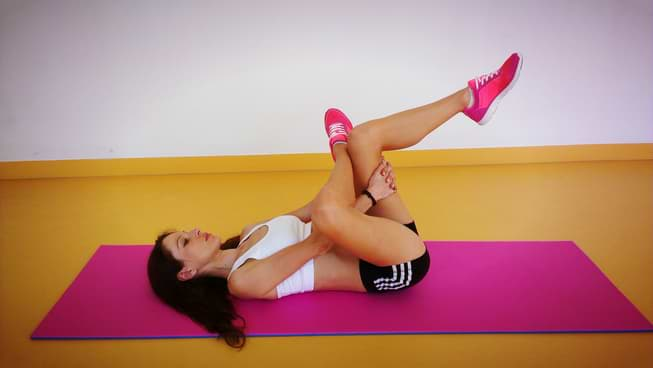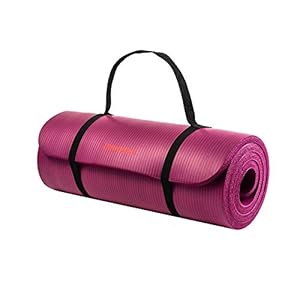Yoga glute stretches are one of the most overlooked and least performed stretching exercises used today. There are many benefits to stretching your glutes that you may not be aware of and should take the time to learn more about.
If you are experiencing issues with tight hips, sore glutes, or lower back pain, then make sure to keep reading and find out how gluteal stretches may be the answer to your problems.
Different types of glute stretching exercises you will find in this article:
- Glute stretching yoga poses on a mat or floor
- Standing glute stretch
- Seated glutes stretch
- Glute stretches with foam rollers
A Comprehensive Guide on Glute Stretching
This comprehensive guide has everything you need to know about the many benefits of glute stretching and includes the top 5 stretching exercises you can perform immediately.
Learn how these exercises can not only help relieve existing symptoms from tight glutes but also how you can benefit proactively with pre-workout and post-workout stretching to help avoid injuries and prevent soreness and pain going forward.
TABLE OF CONTENTS
- What Causes Tight Hips and Sore Glutes?
- How Do I Know If I Have Tight Hips?
- Who can Benefit from Yoga Glute Stretching?
- Top 5 Yoga Glutes Stretches to Loosen Tight Hips [Exercises that Work]
- Glute Stretches with a Foam Roller
- What are some Common Symptoms for Tight Hips?
- When is The Best Time to Perform Glute Stretches?
- What are the Top Benefits of Stretching Your Glutes?
- Final Statement
What Causes Tight Hips and Sore Glutes?
To better prevent tight glutes and the negative side effects they present, let’s first take a look at what causes them in the first place. Here are some top causes for tight glutes you should be aware of.
#1 Long Sitting
Longer periods of sitting at work or while driving, for example, will lead to weak glutes or shortening of the hip flexors. This, in turn, can lead to tight hips and tight glute muscles. As a result, the lower back muscles are forced to work harder as they compensate for the glutes.
#2 Heavy Lifting or Squatting
Repetitive squatting and lifting at work or when moving, for example, will put a lot of emphasis on your glutes and activate muscle fibers you typically don’t use very often. This will cause very tight hips and result in onset soreness that could last for a couple of days. Glute stretching is one of the best ways to relieve this tension and alleviate soreness.
#3 Exercise & Working Out
Squats, lunges, deadlifts, and pretty much any exercises that involve using your glutes can cause tight glutes. Both high repetition and heavy lifting exercises that require your glute muscles can result in tight and sore glutes.
#4 Running
Running does not engage your glute muscles as much as resistance training or squat exercises, but it can cause tight hips after lengthy run sessions. If however you also perform interval sprints, this will most definitely engage your glute muscles and thus may cause tight hips and glutes.
Probably my favorite stretch after a good run or sprinting is the standing glutes stretch. It is both very effective and the most practical to perform when outdoors.
#5 Biking
Another very repetitive movement similar to running is biking. This repetitive movement and limited range of motion over time can eventually lead to hip immobility.
How Do I Know If I Have Tight Hips?
I have found 2 tests that you can perform to find out whether you have tight hips.
The first test, the “Thomas Test” is probably the most used and most trusted test but does require a second person to perform the test.
Our second test, however, does not require a second person and thus can be performed by yourself.
Here is how to perform the Thomas Test:
- Start by lying on your back with your buttocks located at the edge of raised platform or bench.
- Next, pull up both legs to your chest with your hands on each knee.
- The second person then takes one leg and lowers it down.
- If the thigh cannot be lowered to full extension (parallel to the floor), then you have tight hip flexors.
- If the knee cannot bend to 90 degrees while in this position, then you have tight hips.
Here is how to perform the pronation test:
- Start by lying flat on you back on the floor or yoga mat.
- Spread our feet about 2 feet apart.
- Try to rotate both of your legs inward (concentrate on turning your legs or thighs).
- You should be able to equally turn both legs about 40 degrees inward (a good way to gauge this is by viewing the position of both feet).
- If one or both will not rotate to about 40 degrees then you may be experiencing tight hips.
Who can Benefit from Yoga Glute Stretches?
Besides knowing that certain symptoms may be a good indicator for you to perform glute stretching exercises, you may also want to be proactive and prevent these symptoms from occurring in the first place.
The following is a list of popular activities and symptoms where it would be beneficial for you to add glute stretching to your schedule.
You may benefit from glute stretching if you perform these activities:
- Long sitting at the office or when traveling
- Running or sprinting
- Lower body exercise (squats, lunges, deadlifts, etc.)
- Heavy lifting or hard labor
You may benefit from glute stretching if you have these symptoms:
- Soreness in the glutes
- Tightness in the hip area
- Limited mobility in the hips
- Lower back discomfort or tightness
- Tight hamstrings
- Pain or tingling in the glutes
- Knee pain
Top 5 Yoga Glute Stretches to Loosen Tight Hips [Yoga for Tight Glutes]
I consider the following stretches for glutes to be the most effective exercises to loosen tight hips and give your glutes a good stretch. Some of these poses can be performed on the floor or yoga mat, standing, and even while seated in a chair.
I would highly suggest using a yoga mat for any of the following glutes stretching exercises. If you are in need of a good yoga mat, especially the extra-thick mats that provide extra cushion and extra comfort, then check out my review for the best 1″ thick yoga mats found online. Or find the perfect foldable yoga mats you can easily fit into a gym bag for on the go.
So without further ado, here are 5 of my best glute stretches to loosen tight hips.
#1 Lying Yoga Glute Stretches

Here is a step-by-step on how to loosen tight glutes with the lying glute stretch.
- using a yoga mat, lie flat on your back
- raise your knees while keeping your feet flat on your mat
- take one foot and position it so the ankle is slightly above the opposite knee
- now use both hands and grip the other leg from behind and close to the knee bend
- slowly pull back on that leg until you feel the stretch in your opposite glute muscles
- hold this position for about 20 to 30 seconds and repeat for the other side
#2 Pigeon Yoga Pose
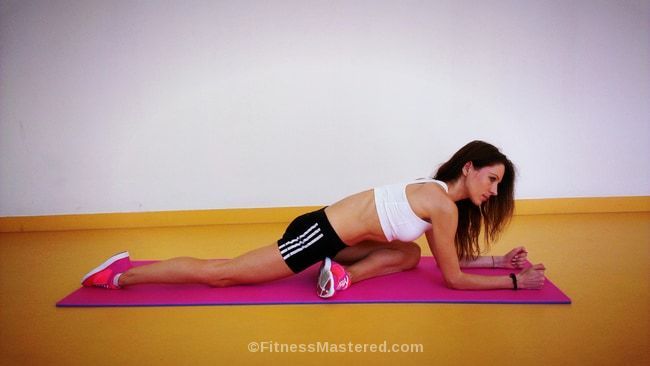
The following is a step-by-step on how to loosen tight hips with the Pigeon Yoga Pose.
The pigeon stretch is one of the more difficult poses to perform. If this is your first time trying this exercise, please use caution when getting into position and when performing this routine.
I have included a video to help you better understand exactly how this exercise is performed so you don’t inadvertently make a wrong move that could cause discomfort later.
- using a comfortable yoga mat, position yourself on your hands and knees
- slowly raise your knees off the mat while keeping your feet on the floor until your legs are straight
- While keeping one leg straight, raise the leg and bring your knee towards your chest
- slightly swing your foot to the inside and lower your hips back down to the mat
- keep your head and torso straight and do not lean or drop your hips to one side
- stay in this position for 20 to 30 seconds and repeat on the other side
- the best way to switch sides is to raise yourself back up again to where both legs are straight and repeat the process as described above
#3 Pretzel Yoga Glute Stretching Pose
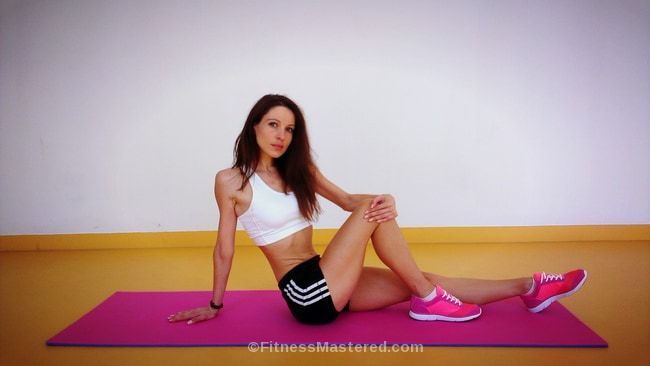
Here is another step-by-step on how to loosen tight glutes with the Pretzel Pose.
- begin by sitting flat on the floor or yoga mat with your legs straight
- now bring one leg up so your heel is positioned close to the opposite knee
- support your weight with the arm opposite from your straight leg
- take your other arm and grip your raised knee
- now pull that knee inward until you feel a good stretch in your glute muscles
- hold this stretch for about 20 to 30 seconds and repeat with the other leg
#4 Seated Gluteal Stretches for Glutes

- position yourself in a chair or on an exercise bench with your feet flat on the floor
- bring one foot up and position it on top of the quad slightly above the knee
- with one or both hands push slightly down on the raised knee while bending forward until you feel a good stretch
- hold this position for 20 to 30 seconds and repeat for the other side
#5 Standing Gluteal Stretches
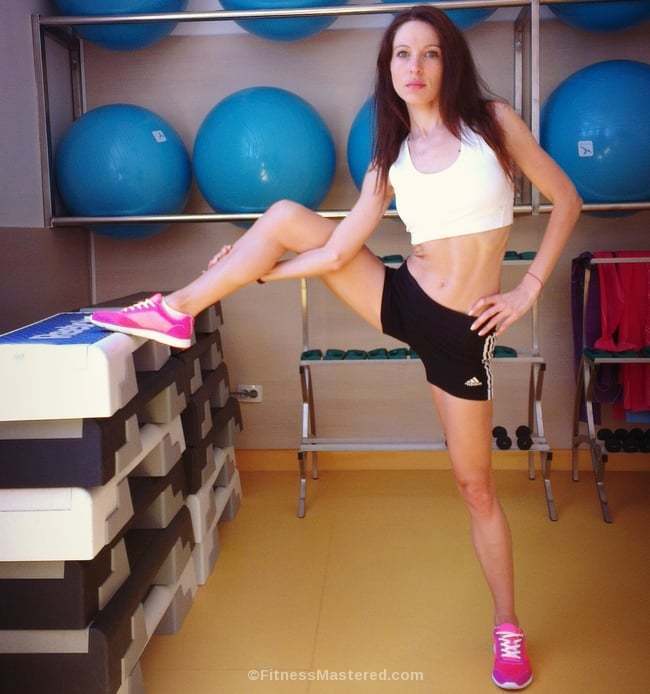
- find a raised platform such as a chair or something higher
- standing parallel to the platform raise one foot up onto the platform
- while keeping your balance, reach under your inner thigh and grip your raised leg above the shin
- now slowly lean into that leg until you feel a good stretch in your glutes
- again, hold that position for about 20 to 30 seconds and repeat on the other side
Stretching Your Glutes with a Foam Roller
In addition to performing yoga for tight glutes, foam rolling is also a very effective way to loosen tight glutes. Repetitive rolling at different angles over the glute muscles as well as targeted pressure point massage is a great way to further loosen up tight glutes.
An even more effective device than just your traditional foam roller and twice as effective is the vibrating foam roller.
Check out my review on the best vibrating foam rollers for deep tissue massage. These rollers will penetrate deeper than any other conventional foam roller on the market.
Here is a great video demonstrating glute stretching with a foam roller by Amanda Edell on Howcast.

What are some Common Symptoms for Tight Hips?
The following are some of the more common symptoms of having tight hips. So if you’re experiencing any of these symptoms, you may want to try incorporating some of our top stretches for glutes to help relieve these symptoms once and for all.
#1 Lower Back Pain
If you’re experiencing lower back pain, and all your back stretching exercises are not doing the trick, then try adding some glute stretching exercises to your routine. Tight hip flexors can result in a pelvic tilt that can cause your lower back to become tight.
#2 Limited Mobility
Tight glutes and shortened hip flexors can limit your range of motion, especially when performing lower body exercises such as squats or deadlifts, but also any activities that require squatting or bending at the hips. If you are feeling stiffness or experiencing limited movement then you may have tight hips.
#3 Glute Pain or Tingling
Tight glutes in some cases may even cause slight pain or tingling in the so-called piriformis muscles. This condition is also known as Piriformis Syndrome. The piriformis muscle helps rotate the hip and turn the leg and foot inward and outward and is located under the gluteus maximus (deep in the buttocks muscle).
#3 Tight Hamstrings
Tight glutes can also cause your hamstrings to tighten. Tight hips can cause a tight lower back and as a result, cause tight hamstrings.
#4 Glute Soreness
Glutes soreness is a good indication that you have tight glutes. This is common after a good day’s work of heavy lifting or squatting movements, or after a good hike, lower body workout, or any other physical activity involving the lower body.
#5 Knee Pain
If the hip is tight and lacks the flexibility to move inward with your leg and foot, then any movements that require pronation of the foot can cause extra stress to the knee.
When is The Best Time to Perform Glute Stretching?
Now that you know who should be doing glute stretching, here is a list of when you should perform them.
- Anytime you feel any of the symptoms from having tight glutes.
- Pre-workout to loosen and stretch muscles for flexibility and to prevent injuries.
- Post-workout to help alleviate onset muscle soreness.
- A few times per week to keep your hips loose and as a preventative measure.
What are the Top Benefits of Stretching Your Glutes?
Glute stretching has many benefits that can both help remedy the side effects of having tight glutes but also proactive by preventing these symptoms from occurring in the first place.
Let’s take a closer look at our top 5 glute stretch benefits and how they can help you.
#1 More Flexibility
More flexibility in the hips will give you more range of motion so thus making it easier to engage in everyday functional activities as well as sports and recreational activities.
#2 Better Performance
With the added flexibility you are better able to perform activities related to squatting, running, or any sports or physical activity involving your lower body.
#3 Pain Relief & Prevention
Performing glutes stretches will help relieve glute soreness from strenuous physical activities and even lower back tightness or knee pain. As a proactive measure, stretching your gluteals can help prevent any of these symptoms resulting from tight hips.
#4 Injury Prevention
Tight hips limit your range of motion and flexibility when performing physical activities. Glutes stretching will unlock that tightness and give you the flexibility to move in a safer and more effective manner. This provides for less strain on your joints and muscles and therefore resulting in fewer injuries.
#5 Prevent Soreness
If you regularly suffer from sore glutes, whether it’s from prolonged sitting or physical activities, performing any of our top 5 glute stretching exercises will greatly help prevent onset soreness.
I have found that stretching both before and after an intense leg or glute workout routine will greatly reduce my muscle soreness over the next couple of days.
Final Statement
Tight hips are very common among sprinters and runners as well as those actively involved in weight training or CrossFit exercises. However, tight hips can also be a side effect of prolonged sitting or long driving.
If you’re experiencing any of the symptoms related to tight glutes, then using our top 5 yoga glute stretches in addition to foam rolling will greatly alleviate any pain you may be having. Performing these stretching exercises will help to prevent pain or injuries in the future while also giving you increased flexibility to perform better at the gym.

With over 30 years of experience in strength training and fitness, Mark LaRue is the founder of Fitness Mastered, a blog to help educate fitness enthusiasts of all fitness levels, ages, and gender. We write topics that range from weight training tips and exercise routines to home workout machine and fitness related product reviews, to name a few.

